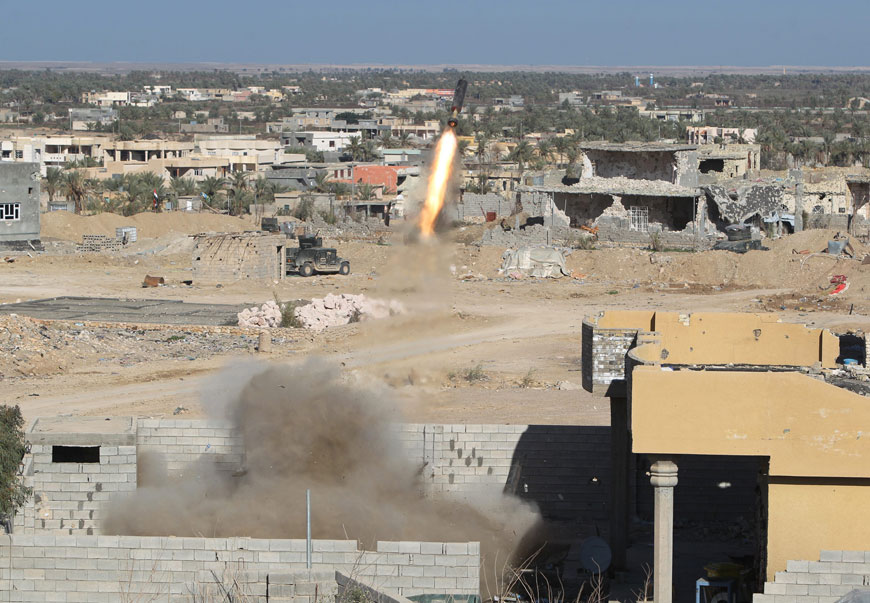BAGHDAD — Iraqi forces were preparing to push further into the centre of the Daesh-held city of Ramadi as the extremist group claimed responsibility for a suicide bombing in Baghdad that killed 11 people on Wednesday.
Backed by US-led air strikes, the Iraqi troops have struggled to roll back Daesh gains since the militants seized large swathes of the country's north and west, along with territories in neighbouring Syria, in the summer of 2014.
Progress in Iraq's vast Anbar Province, west of Baghdad, has been particularly slow, but on Tuesday, Iraqi forces seized a Daesh operations centre and the strategic Tamim neighbourhood on the outskirts of the city.
In Baghdad, meanwhile, a suicide bomber attacked a Shiite mosque, killing at least 11 people and wounding 20 Wednesday, an assault that was promptly claimed by Daesh. Interior ministry spokesman Brig. Gen. Saad Maan said the attacker detonated his bomb in the mosque doorway as worshippers were leaving after midday prayers.
The Daesh claim came in a statement circulated online by its supporters. It bore the group's logo and resembled previous claims issued by the extremists. Daesh has repeatedly targeted Iraq's Shiite majority, who the extremists view as apostates.
In Anbar, Maj. Gen. Ismail Al Mahlawi, the head of Iraqi military operations in the province, said his troops were readying to push “towards the government complex and the Houz area” in central Ramadi.
He told The Associated Press on Wednesday the neighbourhood is the backbone of Daesh’s structure in Ramadi.
The troops’ advances on Tuesday were the most significant incursion into Ramadi since the city fell to Daesh in May. There largest obstacle going forward is crossing the Euphrates River north of the city and its Warar tributary to the west.
Since overrunning Ramadi, Daesh has destroyed all the bridges around the city. It also demolished the Anbar operations command and fanned out into the city’s residential areas to set up less conspicuous centres of command.
“When Ramadi fell in May, it was the last time we saw Daesh take offensive action here in Iraq in any sort of concerted way,” said Brett McGurk, the official in charge of the US-led coalition against Daesh, speaking to reporters Wednesday from the US embassy in Baghdad.
The fall of Ramadi was the biggest blow to Iraqi forces since Daesh captured Iraq’s second largest city of Mosul in the summer of 2014. The government announced a counteroffensive shortly after Ramadi’s fall, but progress has been sluggish.
McGurk cautioned that further advances may also be slow going. “These things take time, Ramadi is a very difficult environment,” he said, adding that it took US forces six months to “take and stabilise Ramadi” from Al Qaeda, Daesh’s precursor.
“Daesh is now resorting to holding the centre of the city while taking human shields as hostages,” McGurk added.
Ramadi residents have reported that Daesh controlled checkpoints in the city have prevented many from fleeing. Estimates of civilians remaining in the city range anywhere from 4,000 to 10,000.
Al Mahlawi, the Iraqi commander in Anbar, said coalition and Iraqi aircraft contributed significantly to the operation, opening “the way before we sent combat units in”. The warplanes “inflicted heavy losses on” Daesh militants, destroying both “equipment and their spirits”.
Muhannad Haimour, the spokesman for the Anbar governor’s office, said he’s receiving reports that Daesh inside Ramadi is collapsing.
“They are trying to flee the city,” he said, citing residents who have been unable to escape, “we believe there are only 300 fighters left.”
But even with little Daesh resistance in terms of numbers, Haimour said clearing territory once it’s been taken back will likely be time-consuming.
“We are very hopeful that Ramadi will be liberated before the end of this year,” he said. “So we’re talking weeks, not months.”
